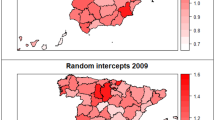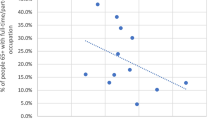Abstract
The aim of this paper is to analyse the determinants of survival in entrepreneurship in Spain. For this purpose, a Cox proportional hazard model is estimated, using information from the Continuous Working Life Sample. The results show that opportunity entrepreneurs have a higher probability of continuing their entrepreneurial activity than entrepreneurs motivated by other reasons. Moreover, women show a higher survival rate than men. In addition, a high educational level positively influences survival, whilst previous work experience increases the risk of not surviving. Finally, age, with a nonlinear influence, increases probability of survival but at a decreasing rate. The implications of these results are that it should not be encouraged entrepreneurship indiscriminately, and authorities should promote entrepreneurial training and help entrepreneurship of people under 30 and over 45–50 years.




Similar content being viewed by others
Notes
The CWLS has been produced since 2004. Each year, new people who are first-time contributors or pensioners are added to those who were already in the sample.
In Table II, instead of showing the hazard ratios, the coefficients are shown, as the comparison was easier.
References
Acs, Z. (2006). “How is entrepreneurship good for economic growth?” Innovations: Technology, Governance. Globalizations, 1(1), 97–107.
Acs, Z., & Storey, D. (2004). Introduction: entrepreneurship and economic development. Regional Studies, 38(8), 871–877.
Amit, R., & Muller, E. (1995). ‘Push’ and ‘pull’ entrepreneurship. Journal of Small Business and Entrepreneurship, 12(4), 64–80.
Andersson, P. (2010). Exits from self-employment: is there a native-immigrant difference in Sweden? International Migration Review, 44(3), 539–559.
Audretsch, D. B. (1991). New-firm survival and the technological regime. The Review of Economics and Statistics, 73(3), 441–450.
Audretsch, D. B., & Keilbach, M. (2004). Does entrepreneurship capital matter? Entrepreneurship: Theory and Practice, 28(5), 419–429.
Audretsch, D. B., & Mahmood, T. (1995). New firm survival: new results using a hazard function. The Review of Economics and Statistics, 77(1), 97–103.
Block, J., & Sandner, P. (2009). Necessity and opportunity entrepreneurs and their duration in self-employment: evidence from German micro data. Journal of Industrial Competition Trade, 9, 117–137.
Borjas, G. (1986). The self-employment experience of immigrants. Journal of Human Resources, 21, 487–506.
Brüderl, J., & Preisendörfer, P. (1998). Network support and the success of newly founded businesses. Small Business Economics, 10(3), 213–225.
Brüderl, J., Preisendörfer, P., & Ziegler, R. (1992). Survival chances of newly founded business organizations. American Sociological Reviews, 57(2), 227–242.
Caliendo, M., & Kritikos, A. S. (2010). Start-ups by the unemployed: characteristics, survival and direct employment effects. Small Business Economics, 35(1), 71–92.
Carrasco, R. (1999). Transition to and from self-employment in Spain: an empirical analysis. Oxford Bulletin of Economics and Statistics, 61(3), 315–341.
Carree, M., van Stel, A., Thurik, R., & Wennekers, S. (2002). Economic development and business ownership: an analysis using data of 23 OECD countries in the period 1976-1996. Small Business Economics, 19, 271–290.
Clark, K., & Drinkwater, S. (2000). Pushed out or pulled in? Self-employment among ethnic minorities in England and Wales. Labour Economics, 7, 603–628.
Clark, K., & Drinkwater, S. (2010). Patterns of ethnic self-employment in time and space: evidence from British census microdata. Small Business Economics, 34(3), 323–338.
Cox, D. R. (1972). Regression models and life tables. Journal of the Royal Statistical Society, 34, 187–220.
Fairlie, R.W. and Lofstrom, M. (2013). “Inmigration and entrepreneurship”, IZA Discussion Paper no. 7669.
Fairlie, R. W., & Robb, M. (2009). Gender differences in business performance: evidence from the characteristics of business owners survey. Small Business Economics, 33(4), 375–395.
Fertala, N. (2008). The shadow of death: do regional differences matter for firm survival across native and immigrant entrepreneurs? Empirica, 35, 59–80.
Fritsch, M., Brixy, U., & Falck, O. (2006). The effect of industry, region and time on new business survival—a multi-dimensional analysis. Review of Industrial Organization, 28, 285–306.
Georgellis, Y., Sessions, J., & Tsitsianis, N. (2007). Pecuniary and non-pecuniary aspects of self-employment survival. The Quarterly Review of Economics and Finance, 47, 94–112.
Giannetti, M., & Simonov, A. (2004). On the determinants of entrepreneurial activity: individual characteristics, economic environment, and social norms. Swedish Economic Policy Review, 11, 269–313.
Haapanen, M., & Tervo, H. (2009). Self-employment in urban and rural locations. Applied Economics, 41(19), 2449–2461.
Kalleberg, A. L., & Leicht, K. T. (1991). Gender and organizational performance: determinants of small business survival and success. Academy of Management, 34(1), 136–161.
Kalnins, A., & William, M. (2014). When do female-owned businesses out-survive male-owned businesses? A disaggregated approach by industry and geography. Journal of Business Venturing, 29(6), 822–835.
Lofstrom, M. (2002). Labor market assimilation and the self-employment decision of immigrant entrepreneurs. Journal of Population Economics, 15(1), 83–114.
Lofstrom, M. and Wang, C. (2006). Hispanic Self-Employment: a dynamic Analysis of Business Ownership, IZA discussion paper no. 2101.
Millan, J. M., Congregado, E., & Román, C. (2012). Determinants of self-employment survival in Europe. Small Business Economics, 38, 231–258.
Millan, J. M., Congregado, E., & Román, C. (2014). Entrepreneurship persistence with and without personnel: the role of human capital and previous unemployment. The International Entrepreneurship and Management Journal, 10(1), 187–206.
Muñoz-Bullón, F., & Cueto, B. (2011). The sustainability of start-up firms among formerly wage-employed workers. International Small Business Journal: Researching Entrepreneurship, 29(1), 78–102.
Munsasinghe, L., & Sigman, K. (2004). A hobo syndrome? Mobility, wages and job turnover. Labour Economics, 11(2), 191–218.
Nafzige, E. W., & Terrell, D. (1996). Entrepreneurial human capital and the long-run survival of firms in India. World Development, 24(4), 689–696.
Nziramasanga, M., & Lee, M. (2002). On the duration of self-employment: the impact of macroeconomic conditions. The Journal of Development Studies, 39(1), 46–73.
Oberschachtsiek, D. (2008). Founders’ experience and self-employment duration: The importance of being a ‘Jack-of-all-trades’. An analysis based on competing risks, IAB-discussion paper, no. 40/2008.
Roberts, P. W., Negro, G., & Swaminathan, A. (2013). Balancing the skill sets of founders: implications for the quality of organizational outputs. Strategic Organization, 11(1), 35–55.
Schuetze, H. J., & Antecol, H. (2006). “immigration, entrepreneurship and the venture start-up process”, the life cycle of entrepreneurial ventures. In S. Parker (Ed.), International Handbook Series on Entrepreneurship, 3 (pp. 107–135). New York: Springer.
Schumpeter, J. A. (1942). Capitalism, socialism and democracy. New York: Harper and Row.
Taylor, M. P. (1999). Survival of the fittest? An analysis of self-employment duration in Britain. The Economic Journal, 109, 140–155.
Therneau, T., Grambsch, P., & Fleming, T. (1990). Martingale based residual for survival models. Biometrika, 77, 147–160.
Van Praag, C. M. (2003). Business survival and success of young small business owners. Small Business Economics, 21(1), 1–17.
Van Stel, A., Carree, M., & Thurik, R. (2005). The effect of entrepreneurial activity on national economic growth. Small Business Economics, 24(3), 311–321.
Wennekers, S., & Thurik, R. (1999). Linking entrepreneurship and economic growth. Small Business Economics, 13(1), 27–55.
Wennekers, S., Stel, A. V., Thurik, R., & Reynolds, P. (2005). Nascent entrepreneurship and the level of economic development. Small Business Economics, 24(3), 293–309.
Author information
Authors and Affiliations
Corresponding author
Rights and permissions
About this article
Cite this article
Cabrer-Borrás, B., Rico Belda, P. Survival of entrepreneurship in Spain. Small Bus Econ 51, 265–278 (2018). https://doi.org/10.1007/s11187-017-9923-1
Accepted:
Published:
Issue Date:
DOI: https://doi.org/10.1007/s11187-017-9923-1
Keywords
- Entrepreneurial survival
- Entrepreneurship
- Opportunity entrepreneurs
- Gender
- Cox proportional hazard model




